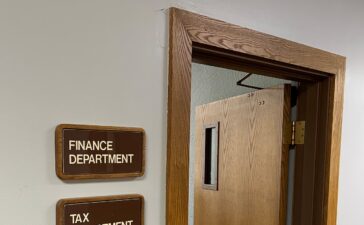CHARLOTTE, N.C. — Every Monday, Renaissance West STEAM Academy math teacher Shelby Lattimore starts her class by charging her students for their seats, not with U.S. currency but with “Lattimore Bucks.” It’s a project she started last year as a way to improve attendance.
“It’s not just about having them here,” Lattimore said. “It’s about having them here for the whole day from start to finish, ready to rock and roll. On top of the fact, just to get them accountable for their behavior and taking accountability for certain things in the classroom.”
Each student is assigned a job in the classroom, which rotates every two weeks.
“These are their jobs,” Lattimore said. “If they’re underlined, they get paid $10. So those are the harder jobs they have to do every day. And then the ones that are not underlined, like this one, he just has to change my calendar. He just has to change the day on the board, like once in the morning so he doesn’t get paid as much.”
With their salaries, her students pay their rent for their seats.
“Their rent was inflated as of January, from $5 to $7,” Lattimore said.
And if students misbehave, they’re fined.
“Like if you purposely lose your pencil, rip your notebook, things of that sort and then of course disrespect,” Lattimore said. “And their fines are a dollar.”
The more Lattimore Bucks they save, the more rewards they can buy. That is, as long as they have enough to pay their rent.
“Let’s say they have $10, but they want to buy lunch with a friend. If I do 10 minus 5, you’re not, you don’t have $7 for your next rent. So they cannot buy anything past their rent that they have to keep in their wallet,” Lattimore said.
While the project may have started to improve effort in the classroom, Lattimore says it’s morphed into a much bigger lesson for her students.
“Some of their parents, you know, thank me all the time,” Lattimore said. “We talk about all the time in Charlotte, generational poverty is a huge statistic here, especially in the kids and the families that we serve in my school.”
She’s instilling lessons of personal finance and budgeting into the lessons every day.
“So just starting the mindset of how can I hold onto money? How can I make long-term decisions with my money? It all starts from a very young age in a safe environment before they’re out in the real world,” Lattimore said.
It’s done in hopes of setting up her students for the future.
“Even my students from last year, they are telling me that they’re saving their money, and they’re budgeting their Christmas money for a pair of sneakers or whatever they want,” Lattimore said. “So they’re holding onto the lesson. So I can only imagine a couple of years from now when they’re adults, how that will affect their family.”
Lattimore says other teachers she knows have started similar programs in their own classrooms. She says the concept can be used at any school for any grade level as a simple way to teach basic finances.

















